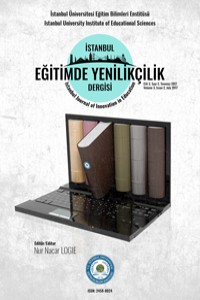THE PROBLEM OF TRANSITION FROM WRITTEN DICTIONNARIES TO VOICED AND VISUAL DICTIONNARIES IN LANGUAGE TEACIN
Öz
In the field of lexicology, there have been important findings in terms of importance of visuality. Because it is impossible to use visuality for all printed words, there are no important improvements. With the appearance of digital system and web-based dictionaries, visual dictionaries have been developed. Besides, new technology makes it possible to support visual dictionaries vocally. In our research, we will discuss usage of visual dictionaries by investigating the works related to visual dictionaries and how understanding of them can be adapted into Turkish language.Also a visual dictionary arranges animals, body parts, plants, vehicles, etc according to thematic order. Therefore, accessibility becomes easier and disorder resulting from alphabetic arrangement will be removed. With visual dictionaries, people can get what the image stands for and when they want, they can listen to their names using vocal dictionaries. In our research, we will discuss briefly the most efficient usage of visual dictionary in our language classroom and the impact of the processes of language teaching.
Anahtar Kelimeler
visuality image sound sense e-dictionaries language teaching
Kaynakça
- Bourissoux J.L. &Pelpel, P.(1992) Enseigner avec l’audio-visuel , ed , d’organisation, Paris.
- Coste, D. (1975c). L’image en didactique des langues. Etudes de Linguistique Appliquée. (ELA). 17
- Deschamps, F. (2004) : Lire l’image au collège et au lycée en cours de français , Hatier , Paris Diller,
- Floréz, C.(1974) : La mémoire, 2ème Ed , presse universitaire de France, Paris
- Galisson , R., & Coste, D. (1976). dictionnaire de didactique des langues. Paris: Hachette.
- Lecarme, P.H (2006) L’image enfin prise au sérieux? (2018, 8 ocak) in http://www.cahiers-pedagogiques.com/L-image-enfin-prise-au-serieux
- Legros D. & Crinon (2002) : Psychopédagogie des apprentissage et multimédia , Armand colin, Paris
- Levend, A.S. (1969) : Şemsettin Sami, Ankara Üniversitesi Basımevi, Ankara
- Mialeret G. (1964) : Psychopédagogie des moyens audio-visuel dans l’enseignement du 1er degré,Uneco, Paris
- Mondria, J.A. (1996) : Vocabulaireverwerving in het vreemdetalenonderwijs. Thèse de Doctorat Université de Groningue
- Najjar, L. J. (1996). Multimedia information and learning. Journal of Educational Multimedia and Hypermedia, 5, 129-150
- Paivio, A. (1971) : Imagery and verbal processes. London, Holt, Rinehardt and Winston.
- Schouten-van Parreren, C. (1985) : Woorden leren in het vreemdetalenonderwijs. Apeldoorn, van Walraven.
Öz
Sözlük bilim alanında görselliğin önemine dair eskiden beri önemi vurgulanmıştır. Matbu sözlüklerde tüm görsellerin kullanılması imkânsız olduğu için bu alanda önemli gelişmeler sağlanamamıştır. Günümüzde dijital sistemin ve web tabanlı sözlüklerin ortaya çıkmasıyla birlikte görsel sözlük adıyla yeni bir sözlük anlayışı geliştirilmiştir. Ayrıca yeni teknoloji görsel sözlüklerin sesli olarak desteklenmesine imkân sağlamıştır. Bu araştırmamızda görsel sözlükle ilgili yapılan çalışmaları inceleyerek bu tür sözlüklerin ülkemizde de kullanılmasını, Türk diline görsel sözlük anlayışının nasıl uyarlanabileceğini ele alacağız. Dil öğretiminde kavram haritalarına başvurmanın ne kadar önemli olduğu düşünüldüğünde görsel sözlüklerin de dil ediniminde ne denli etkili olacağı aşikârdır. Görsel bir sözlük hayvanları, insan vücudunu, bitkileri, motorlu taşıtları vs. tematik sıralamaya göre tanzim etmektedir. Böylece kolay erişilebilirlik sağlanmakla birlikte alfabetik sıralamanın yaratabileceği dağınıklardan da kurtulabilmekteyiz. Sözlüklerde yer alan resimler sayesinde bilinmeyen kelimelerin görsel olarak ne ifade ettiğini görebilmekte ve istenildiği bu sözcüklere sesli olarak da erişebilmektedir. Hülasa olarak bu çalışmamızda görselliğin öğrenme sürecine etkisi ve görsel sözlüğün dil sınıfında etkili bir şekilde nasıl kullanılabileceği üzerine duracağız.
Anahtar Kelimeler
Kaynakça
- Bourissoux J.L. &Pelpel, P.(1992) Enseigner avec l’audio-visuel , ed , d’organisation, Paris.
- Coste, D. (1975c). L’image en didactique des langues. Etudes de Linguistique Appliquée. (ELA). 17
- Deschamps, F. (2004) : Lire l’image au collège et au lycée en cours de français , Hatier , Paris Diller,
- Floréz, C.(1974) : La mémoire, 2ème Ed , presse universitaire de France, Paris
- Galisson , R., & Coste, D. (1976). dictionnaire de didactique des langues. Paris: Hachette.
- Lecarme, P.H (2006) L’image enfin prise au sérieux? (2018, 8 ocak) in http://www.cahiers-pedagogiques.com/L-image-enfin-prise-au-serieux
- Legros D. & Crinon (2002) : Psychopédagogie des apprentissage et multimédia , Armand colin, Paris
- Levend, A.S. (1969) : Şemsettin Sami, Ankara Üniversitesi Basımevi, Ankara
- Mialeret G. (1964) : Psychopédagogie des moyens audio-visuel dans l’enseignement du 1er degré,Uneco, Paris
- Mondria, J.A. (1996) : Vocabulaireverwerving in het vreemdetalenonderwijs. Thèse de Doctorat Université de Groningue
- Najjar, L. J. (1996). Multimedia information and learning. Journal of Educational Multimedia and Hypermedia, 5, 129-150
- Paivio, A. (1971) : Imagery and verbal processes. London, Holt, Rinehardt and Winston.
- Schouten-van Parreren, C. (1985) : Woorden leren in het vreemdetalenonderwijs. Apeldoorn, van Walraven.
Ayrıntılar
| Birincil Dil | Türkçe |
|---|---|
| Bölüm | Editorial and Advisory Board |
| Yazarlar | |
| Yayımlanma Tarihi | 2 Temmuz 2017 |
| Yayımlandığı Sayı | Yıl 2017 Cilt: 3 Sayı: 2 |


